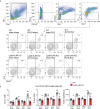M2 Macrophages promote IL-33 expression, ILC2 expansion and mucous metaplasia in response to early life rhinovirus infections
- PMID: 36032072
- PMCID: PMC9412168
- DOI: 10.3389/fimmu.2022.952509
M2 Macrophages promote IL-33 expression, ILC2 expansion and mucous metaplasia in response to early life rhinovirus infections
Abstract
Wheezing-associated rhinovirus (RV) infections are associated with asthma development. We have shown that infection of immature mice with RV induces type 2 cytokine production and mucous metaplasia which is dependent on IL-33 and type 2 innate lymphoid cells (ILC2s) and intensified by a second heterologous RV infection. We hypothesize that M2a macrophages are required for the exaggerated inflammation and mucous metaplasia in response to heterologous RV infection. Wild-type C57Bl/6J mice and LysMCre IL4Rα KO mice lacking M2a macrophages were treated as follows: (1) sham infection on day 6 of life plus sham on day 13 of life, (2) RV-A1B on day 6 plus sham on day 13, (3) sham on day 6 and RV-A2 on day 13, or (4) RV-A1B on day 6 and RV-A2 on day 13. Lungs were harvested one or seven days after the second infection. Wild-type mice infected with RV-A1B at day 6 showed an increased number of Arg1- and Retnla-expressing lung macrophages, indicative of M2a polarization. Compared to wild-type mice infected with RV on day 6 and 13 of life, the lungs of LysMCre IL4Rα KO mice undergoing heterologous RV infection showed decreased protein abundance of the epithelial-derived innate cytokines IL-33, IL-25 and TSLP, decreased ILC2s, decreased mRNA expression of IL-13 and IL-5, and decreased PAS staining. Finally, mRNA analysis and immunofluorescence microscopy of double-infected LysMCre IL4Rα KO mice showed reduced airway epithelial cell IL-33 expression, and treatment with IL-33 restored the exaggerated muco-inflammatory phenotype.
Conclusion: Early-life RV infection alters the macrophage response to subsequent heterologous infection, permitting enhanced IL-33 expression, ILC2 expansion and intensified airway inflammation and mucous metaplasia.
Keywords: IL-33; ILC2; M2 macrophage; Rhinovirus; neonate.
Copyright © 2022 Han, Breckenridge, Kuo, Singh, Goldsmith, Li, Kreger, Bentley and Hershenson.
Conflict of interest statement
The authors declare that the research was conducted in the absence of any commercial or financial relationships that could be construed as a potential conflict of interest.
Figures







Similar articles
-
Early-life heterologous rhinovirus infections induce an exaggerated asthma-like phenotype.J Allergy Clin Immunol. 2020 Sep;146(3):571-582.e3. doi: 10.1016/j.jaci.2020.03.039. Epub 2020 Apr 25. J Allergy Clin Immunol. 2020. PMID: 32344055 Free PMC article.
-
IL-1β prevents ILC2 expansion, type 2 cytokine secretion, and mucus metaplasia in response to early-life rhinovirus infection in mice.Allergy. 2020 Aug;75(8):2005-2019. doi: 10.1111/all.14241. Epub 2020 Mar 10. Allergy. 2020. PMID: 32086822 Free PMC article.
-
The Innate Cytokines IL-25, IL-33, and TSLP Cooperate in the Induction of Type 2 Innate Lymphoid Cell Expansion and Mucous Metaplasia in Rhinovirus-Infected Immature Mice.J Immunol. 2017 Aug 15;199(4):1308-1318. doi: 10.4049/jimmunol.1700216. Epub 2017 Jul 12. J Immunol. 2017. PMID: 28701507 Free PMC article.
-
Innate Immune Responses by Respiratory Viruses, Including Rhinovirus, During Asthma Exacerbation.Front Immunol. 2022 Jun 20;13:865973. doi: 10.3389/fimmu.2022.865973. eCollection 2022. Front Immunol. 2022. PMID: 35795686 Free PMC article. Review.
-
Rhinovirus Attributes that Contribute to Asthma Development.Immunol Allergy Clin North Am. 2019 Aug;39(3):345-359. doi: 10.1016/j.iac.2019.03.004. Epub 2019 May 7. Immunol Allergy Clin North Am. 2019. PMID: 31284925 Free PMC article. Review.
Cited by
-
M2 macrophages participate in ILC2 activation induced by Helicobacter pylori infection.Gut Microbes. 2024 Jan-Dec;16(1):2347025. doi: 10.1080/19490976.2024.2347025. Epub 2024 May 1. Gut Microbes. 2024. PMID: 38693666 Free PMC article.
-
Alveolar macrophages and airway hyperresponsiveness associated with respiratory syncytial virus infection.Front Immunol. 2022 Oct 20;13:1012048. doi: 10.3389/fimmu.2022.1012048. eCollection 2022. Front Immunol. 2022. PMID: 36341376 Free PMC article. Review.
-
Infection of Immature Mice with Rhinovirus for the Study of Asthma Pathogenesis.Methods Mol Biol. 2025;2903:173-184. doi: 10.1007/978-1-0716-4410-2_14. Methods Mol Biol. 2025. PMID: 40016466
-
Macrophages Orchestrate Airway Inflammation, Remodeling, and Resolution in Asthma.Int J Mol Sci. 2023 Jun 21;24(13):10451. doi: 10.3390/ijms241310451. Int J Mol Sci. 2023. PMID: 37445635 Free PMC article. Review.
-
Monitoring Macrophage Polarization in Infectious Disease, Lesson From SARS-CoV-2 Infection.Rev Med Virol. 2025 May;35(3):e70034. doi: 10.1002/ird3.70006. Rev Med Virol. 2025. PMID: 40148134 Free PMC article. Review.
References
Publication types
MeSH terms
Substances
Grants and funding
LinkOut - more resources
Full Text Sources
Molecular Biology Databases
Research Materials
Miscellaneous

